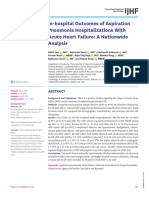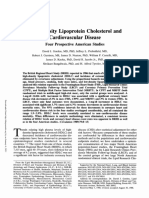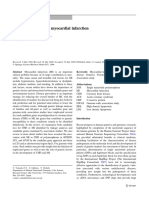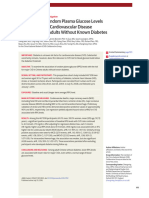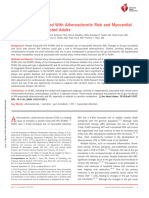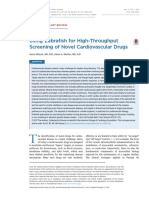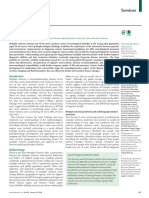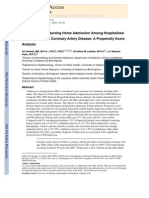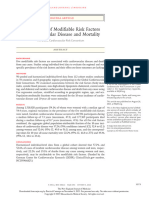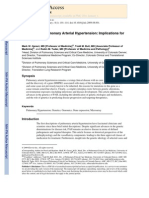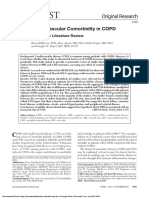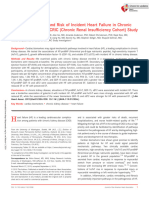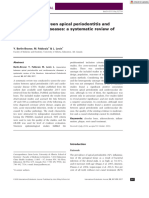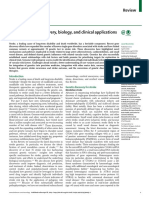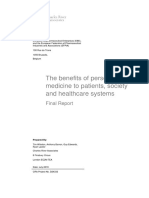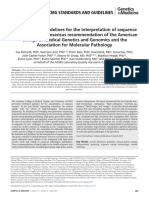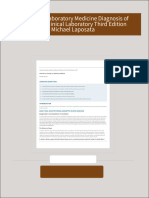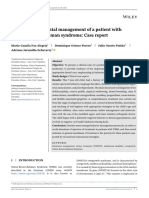Cardiovascular Disease Genomic Research
Cardiovascular Disease Genomic Research
Uploaded by
Adrián Asael Rodriguez CortesCopyright:
Available Formats
Cardiovascular Disease Genomic Research
Cardiovascular Disease Genomic Research
Uploaded by
Adrián Asael Rodriguez CortesCopyright
Available Formats
Share this document
Did you find this document useful?
Is this content inappropriate?
Copyright:
Available Formats
Cardiovascular Disease Genomic Research
Cardiovascular Disease Genomic Research
Uploaded by
Adrián Asael Rodriguez CortesCopyright:
Available Formats
NIH Public Access
Author Manuscript
Clin Chem. Author manuscript; available in PMC 2013 May 10.
Published in final edited form as:
NIH-PA Author Manuscript
Clin Chem. 2012 January ; 58(1): 113–126. doi:10.1373/clinchem.2011.170423.
Next Steps in Cardiovascular Disease Genomic Research –
Sequencing, Epigenetics, and Transcriptomics
Renate B. Schnabel, MD, MSc1, Andrea Baccarelli, MD, PhD2, Honghuang Lin, PhD3,4,
Patrick T. Ellinor, MD, PhD5,6, and Emelia J. Benjamin, MD, ScM3,7
1Department of General and Interventional Cardiology, University Heart Center Hamburg,
Hamburg, Germany
2Laboratory of Environmental Epigenetics, Exposure Epidemiology and Risk Program, Harvard
School of Public Health, Boston, Massachusetts
3National
Heart Lung and Blood Institute’s and Boston University’s Framingham Heart Study,
Framingham, Massachusetts
4Department of Medicine, School of Medicine, Boston University, Boston, Massachusetts
NIH-PA Author Manuscript
5Cardiovascular Research Center, Massachusetts General Hospital, Charlestown, Massachusetts
6Cardiac Arrhythmia Service, Massachusetts General Hospital, Boston, Massachusetts
7Cardiologyand Preventive Medicine Sections, Department of Medicine, School of Medicine,
Boston University, Boston, Massachusetts
Abstract
BACKGROUND—Genomic research in cardiovascular disease (CVD) has progressed rapidly
over the last five years. However, in most cases these ground-breaking observations have not yet
been accompanied by clinically applicable tools for risk prediction, diagnosis, or therapeutic
interventions.
CONTENT—We reviewed the English literature for novel methods and promising genomic
targets that will permit large-scale screening and follow-up of recent genomic findings for CVD.
We anticipate that advances in three key areas will be critical for the success of these projects.
First, exome-centered and whole genome next generation sequencing will identify rare and novel
genetic variants associated with CVD and its risk factors. Improvements in methods will also
NIH-PA Author Manuscript
greatly advance the field of epigenetics and gene expression in humans. Second, research
increasingly acknowledges that static DNA sequence variation explains only a fraction of the
inherited phenotype. Therefore we expect that multifold epigenetic and gene expression signatures
will be related to CVD in experimental and clinical settings. Leveraging existing large-scale
consortia and clinical biobanks combined with electronic health records holds promise to integrate
epidemiological and clinical genomics data. Finally, a systems biology approach will be needed to
integrate the accumulated multidimensional data.
SUMMARY—Novel methods in sequencing, epigenetics and transcriptomics, and unprecedented
large-scale cooperative efforts promise to generate insights into complex CVD. The rapid
accumulation and integration of knowledge will shed light onto the considerable proportion of the
missing heritability of CVD.
Correspondence to: Renate B. Schnabel.
Schnabel et al. Page 2
Keywords
genomics; sequencing; epigenetics; transcriptomics
NIH-PA Author Manuscript
Cardiovascular disease (CVD) morbidity and mortality pose a significant public health
burden worldwide (1). Understanding the multifactorial, complex underpinnings of CVD
holds promise to have global impact on health promotion. CVD is a heritable condition(2),
with heritability estimates of up to 60 percent for coronary heart disease(3). The completion
of the Human Genome Project(4) has raised high expectations for substantial insights into
the polygenetic architecture of complex human diseases such as CVD. However, despite the
rapid identification of a few genetic variations for CVD and its risk factors, the number of
findings that have been translated into clinical practice has remained disappointingly low.
For this review, we searched the current literature for novel methods and scientific
approaches that may follow-up the recent genomic findings for CVD variants and ultimately
enable large-scale screening in clinical samples and the general population.
Common complex disease
Unlike Mendelian disorders, there not exist a single genetic variant that is responsible for
CVD (Table 1). Rather, CVD phenotypes and other complex diseases result from the sum of
multiple polymorphisms, each with relatively small effects on gene expression and disease.
NIH-PA Author Manuscript
Genome-wide association studies (GWAS) have been conducted to dissect the contribution
of common polymorphisms and have lead to the identification of more than 20 new loci
related to myocardial infarction and other CVD phenotypes(5). Figure 1 summarizes the
results of GWAS findings for CVD and its risk factors.
Whereas GWAS has had great success in identifying genetic loci for CVD, many challenges
remain. First, these studies typically use only common SNPs which by definition have an
allele frequency of over 1%. Thus, rarer SNPs with stronger effects may not be identified by
GWAS. Second, as for all association analyses, a clear CVD phenotype is required. For
instance, distinct phenotypes of coronary artery disease with different heritability patterns
exist(6) that have often been largely ignored in genomic analyses to date. Clinically
important variation in manifestation, therapeutic approach and prognosis exist for
phenotypes such as left main disease, diffuse versus focal coronary artery disease, ectatic
lesions, and degree of coronary calcification. The harmonization of clinically relevant and
rigorously defined phenotypes across cohorts is essential to better delineate genetic
associations. For continuous and well-standardized phenotypes such as blood lipids highly
significant statistical associations have been shown, but they generally have very modest
NIH-PA Author Manuscript
effect sizes(7).
The exact pathophysiological mechanisms behind the vast majority of common genetic
polymorphisms from GWAS screening are largely unknown. In many cases the search for
the functional variants has been rendered more difficult by the unexpected observation that
many genome-wide hits are located in non-coding genomic regions and gene deserts as
shown for the 9p21 locus consistently related to CVD(8;9) and the 4q25 locus for atrial
fibrillation(10). Finally, the identified genetic variants often explain less than 10 percent of
trait or diseasevariability (11). Even the combination of information on an increasing
number of common genetic variants promises low discriminatory ability due to small
absolute variation in risk between carriers and non-carriers of the alleles (12). Hundreds of
frequent genetic variants explain a small proportion of inter-individual common phenotype
variability (13;14), and the hypothesis has been raised that some of the missing heritability
Clin Chem. Author manuscript; available in PMC 2013 May 10.
Schnabel et al. Page 3
could be explained by rare/low frequency variants, structural alterations, and epigenetics
(15;16).
NIH-PA Author Manuscript
Despite these challenges, there are a few examples of genetic loci in which the functional
importance of a SNP has been elucidated. In a recent elegant investigation of a low-density
lipoprotein cholesterol levels GWAS result, a common noncoding polymorphism at the
chromosome 1p13 locus was reported to create a transcription factor binding site and alter
the expression of the SORT1 gene. In turn, SORT1 affects very low-density lipoprotein
secretion in the liver, and potentially may represent a causal pathway from blood lipids to
myocardial infarction. Such experiments show the value of whole-genome association study
efforts when complemented with follow up functional investigations (17).
Given the challenges posed by the recent GWAS findings and the gaps that remain in
translating these findings into clinical practice, in the remainder of the article we will focus
on three emerging areas that will be critical to advancing our understanding of CVD
phenotypes. Specifically, we will review the application of next generation sequencing,
epigenetics, and transcriptomics to CVD phenotypes. We will discuss the importance of
utilizing systems biology to integrate data across genomic platforms, and we will consider
the potential relevance of genomic findings to the clinical setting.
Next Generation Sequencing
NIH-PA Author Manuscript
Traditional Sanger sequencing has high-fidelity, but is slow and quite expensive relative to
next generation methods. Recent advances in sequence-based technology permit massive
parallel sequencing (Table 2). Real-time sequencing replaces natural nucleotides or
reversible terminators by detection of continuously added fluorescence labeled nucleotides
to the growing DNA strand enhancing the speed and output length of nucleotides(18). The
establishment of sequencing libraries and post-sequencing bioinformatics algorithms
facilitate the generation, reconstruction, and analysis of sequence reads. Optimizing
sequencing accuracy and redundant sequencing reduce sequencing errors. Bioinformatics
tools are continuously being refined to store and process the massive amount of sequence
data.
Several challenges remain with next generation sequencing. Platforms differ by template
preparation, sequencing chemistry, imaging, read length and quantity per run. Quality
measures are provided by the respective manufacturers, but a uniform quality assessment
protocol has not been implemented. Statistical analyses need to account for type I error in
the resulting huge data sets and need to develop methods to dissect phenotype relevant
variants from commonly shared alleles. Clustering of the total data into conceptually related
parts facilitates information digestion(19). Finally, the identification of disease specific
NIH-PA Author Manuscript
genetic variants from bystanders remains a challenge.
Despite these limitations, next generation sequencing has already shown great success and
the methods for sequencing have evolved to the point that within the last year sequencing of
an entire genome has become considerably less expensive and straightforward. Next
generation sequencing has been applied to follow up GWAS loci for CVD phenotypes, to
identify rare forms of CVD traits by exome sequencing, and to identify structural variation
in the genome.
Evaluation of GWAS loci for CVD phenotypes—The design of GWAS largely has
been restricted to genotyping common alleles. However, the accumulating evidence of
GWAS suggests that frequent polymorphisms with small odds ratios are unlikely to explain
all familial clustering of CVD. Hence, the common disease – common variant rule has to be
reconsidered. Instead, many heterogeneous rare or low frequency variants in the population
Clin Chem. Author manuscript; available in PMC 2013 May 10.
Schnabel et al. Page 4
are hypothesized to explain larger proportions of heritability than previously assumed. Re-
sequencing or deep sequencing of the candidate genomic region provides a focused
approach to assess common as well as less frequent genetic variation at the site of interest as
NIH-PA Author Manuscript
a follow-up of GWAS. Sequencing in larger clinical or even population-based samples
requires different prerequisites in methodology compared to Mendelian cardiovascular
disorders (Table 1).
Exome sequencing in rare and common forms of CVD—Time and effort can be
reduced by focusing on transcribed gene regions in transcriptome or exome sequencing, but
leaves out non-coding regions, which may also be of scientific interest, as shown in many
GWAS findings. Exome sequencing also will provide a means to shed light on alternative
splicing variants in relation to CVD on the way from transcription to translation. In addition,
the completion of the 1000 Genomes Project (http://www.1000genomes.org) will give a
comprehensive genotype map in HapMap populations that will provide novel variants and
may answer many questions without the need of re-sequencing.
Whereas to date, sequencing has mainly been limited to unraveling single or oligogenic
CVD causes, the determination of complete DNA sequences of human individuals will bring
next generation sequencing technology to the population level. A publicly funded large-
scale effort on the application of next generation sequencing to study the protein coding
regions of the human genome is the Grand Opportunity Exome Sequencing Project. The
NIH-PA Author Manuscript
study of well-phenotyped cohorts is intended to discover low frequency alleles and novel
polymorphisms with large effect sizes as correlates of complex phenotypes and affiliated
mechanisms contributing to CVD. The sequencing results and discoveries will be made
available to the scientific community in order to improve diagnosis and management of
diseases (https://esp.gs.washington.edu/drupal/).
As more experience is accumulated the understanding of the genetic architecture of CVD
will deepen. For example, to date, it is largely unknown what role modifier sequence
variants play in common CVD. Modifier sequence variants may be important correlates of
phenotypes in single gene disorders as they may determine nuances of phenotype besides the
primary, causal alleles(20). In common diseases we have been lacking the power to
investigate subtle differences that distinguish modifier sequence variants from non-causal
variation that is inherited.
Structural variation—The pathophysiological significance of structural variants to CVD
is incompletely understood and may range from direct disease association, to quantitatively
or qualitatively modifying disease phenotype to no relevant effect. Deletions or insertions
affecting one to more than a million base pairs are frequently observed throughout the
NIH-PA Author Manuscript
genome(21). Smaller studies have investigated insertions and deletions in relation to CVD
phenotypes such as hypertension and coronary heart disease(22). An insertion/deletion was
found in the angiotensin I converting enzyme and has repeatedly been reported in relation to
CVD and its risk factors(23).
Among structural variation, copy number variation (CNV) has been an emerging focus of
interest. In non-syndromal CVD, an exonic deletion in the BCL2-associated athanogene 3
(BAG3) gene was related to dilated cardiomyopathy in a multigenerational family with
autosomal dominant transmission of the disease(24). At the population level, investigations
of SNPs and CNVs revealed potential associations with aortic root diameter in hypertensive
African Americans(25). In sporadic as well as familial aortic aneurysms and dissections rare
CNVs disrupting smooth muscle adhesion or contraction have been identified in inherited
forms of aneurysms(26).
Clin Chem. Author manuscript; available in PMC 2013 May 10.
Schnabel et al. Page 5
To date, no robustly replicated CNVs in relation to CVD have been identified that could
have been added to Figure 1. Initial evidence for CNV in early-onset myocardial infarction
did not detect differences for genome-wide common and rare CNVs, the number of genes
NIH-PA Author Manuscript
intersected by CNVs, or the total extent of CNVs compared to controls(27). More detailed
analyses will be needed to comprehensively assess the implication of CNVs to CVD.
Epigenetics
New sequencing methods also will provide high-resolution maps of epigenetics(28).
Epigenetics investigates mechanisms of gene-expression controls independent to genetic
variations(29). The most investigated epigenetic modifications are DNA methylation,
histone modifications, and nucleosome positioning.
DNA methylation is the covalent methylation of cytosines catalyzed by DNA
methyltransferases located in CG dinucleotides (CpGs). Usually, methylated regions are not
actively transcribed, and are silenced in fully differentiated tissues (30). In contrast, non-
methylated regions mark genes that are either actively expressed or poised to be
expressed(31). DNA methylation has been predominantly investigated in regions enriched
with CpGs named CpG islands. Whereas CpG islands have been classically considered the
main regulatory regions for methylation-related control of gene expression, recent work has
suggested that CpG island “shores”, i.e., regions less dense in CpG content located up to
2Kb away from the islands, may be even more enriched in regulatory sequences(32). DNA-
NIH-PA Author Manuscript
methylation can be determined using a candidate-gene approach through bisulfite-
pyrosequencing OR MASS-array, or using genome-scale analyses by methylation
microarrays or sequencing-based technologies including reduced representation bisulphite
sequencing, methylC-sequencing, methylated DNA immunoprecipitation sequencing, or
methylated DNA binding domain sequencing(33;34).
The major histones H2A, H2B, H3 and H4 group into globular polymers and form the
nucleosomes around which DNA segments are wrapped(35). Histones are not just structural
units, but undergo covalent posttranscriptional modifications including methylation,
phosphorylation, acetylation, and ubiquitination. Those histone modifications appear to
regulate chromosome condensation, gene expression, splicing, and DNA repair mechanisms.
The third major epigenetic regulator of gene transcription is nucleosome positioning. The
presence and location of nucleosomes directly interfere with the transcription process. DNA
organization in nucleosomes inhibits access of transcription factors and polymerases.
Nucleosome-free gene start sites are needed to allow the assembly of the transcription
complex and activity of RNA polymerases. The initiation and orchestration of epigenetic
mechanisms is little understood. It has been assumed that interaction between epigenetic
NIH-PA Author Manuscript
factors may be central to direction of DNA methylation, histone modification and chromatin
remodeling(36).
Epigenetics may be a unifying principle in the etiology of complex diseases(37). In contrast
to the static DNA backbone, epigenetic modifications, albeit genetically determined, can
also be modified by environmental influences and are dynamic over time(38). Whereas our
knowledge on epigenetics and expectations are largely derived from cancer research in
which hypomethylation of non-coding DNA and de-novo hypermethylation of tumor
suppressor genes has been regularly reported in malignant cells, experience with CVD
associations is still much less substantiated.
Epigenetic marks are almost entirely established during embryogenesis and early
development and may impact cardiovascular development through stem cell control and
differentiation of endothelial and cardiac and vascular muscle cells. During early
Clin Chem. Author manuscript; available in PMC 2013 May 10.
Schnabel et al. Page 6
development DNA methylation is mostly dependent on availability of folic acid and other
nutrients in the methyl-donor cycle. Genomic DNA methylation directly correlates with
folate status and prenatal folic acid deficiency has been suggested to represent a link to early
NIH-PA Author Manuscript
CVD development and the observation that early atherosclerosis may begin in utero(39).
Along these lines, intrauterine exposure to dietary protein restriction can lead to
hypertension and endothelial dysfunction in rat offspring, the exact mechanisms being
unknown(40).
Endothelial shear stress also has been identified as a trigger of early angiogenic processes
and vascular development through by histone deacetylases(41). During early stages of
atherosclerosis in apolipoprotein E null mice, global hypomethylation precedes
histologically detectable vascular lesions(42). Among proteins that specifically recognize
CpG methylated DNA regions is methyl-CpG–binding domain protein 2 which activates
histone deacetylases and suppresses gene transcription. Knockdown of the protein was
shown to exhibit beneficial effects on endothelial nitric oxide synthase, induce angiogenesis,
and to be protective against limb ischemia(43). Observations seemed to be specific to
vascular endothelium and promise success in targeted modulation. In fact, endothelial nitric
oxide synthase shows striking methylation differences in endothelial cells with highest
activity compared to dense methylation in non-endothelial cell types(44).
Hypoxia leads to a global reduction in transcription activity reflected in upregulation of
NIH-PA Author Manuscript
ubiquitous repressive histone methylation(45). Histone modifications seem to be mandatory
to maintain constitutive endothelial nitric oxide synthase transcriptional activity. Acetylation
of proximal promoter histones under hypoxia results in repression of transcription with
deleterious effects on vascular homeostasis(46). Similarly, histone deacetylase 3 has been
demonstrated to be critical in endothelial survival and atherosclerosis development in
response to disturbed blood flow at vessel bifurcations that are known to be prime locations
of atherosclerosis development(47).
Diabetes mellitus is a major risk factor for CVD with clear environmental and genetic
influences. Epigenetics modifications have been invoked as potentially causal for diabetes in
integrating DNA code and external influences(48). DNA methylation of the insulin
promoter region is inversely related to insulin production. De-methylation in mature human
insulin-producing cells affects insulin secretion, and pathological methylation patterns in
context with environmental influences have been suggested to contribute to development of
diabetes(49). At a population level, a differentially methylated CTCF-binding site at 11p15
was discovered in relation to type 2 diabetes(50).
There is exponentially advancing availability of increasingly robust data sets with the fine
NIH-PA Author Manuscript
mapping of the human DNA methylome at base resolution(33), genome-wide nucleosome
positioning maps, and the continuing identification of new variants and modifications.
Online epigenetics resources have been assembled recently (for review see(51)).
Whereas we have gained most epigenomic insights from basic science, epidemiologic data
have remained scarce. We are at the beginning of understanding that epigenetic
modifications of the genome may be as important as the DNA information itself in the
stable, vertical transmission of gene expression and heritability of phenotypes.
Transcriptomics
A further layer of complexity is added at the transcriptional level. Gene expression is
determined by genetic and environmental influences. It can be assumed that qualitative, and,
to a larger extent, quantitative differences in gene expression determine an individual’s
phenotype(52). Subtle changes in splice site variations, 3’ untranslated regulatory regions,
Clin Chem. Author manuscript; available in PMC 2013 May 10.
Schnabel et al. Page 7
non-coding RNAs, and direct interaction of transcription factors may have significant effects
on gene expression patterns and CVD phenotypes that can only be assessed by transcriptome
interrogation. Single time point transcriptomics analysis represents a snapshot of cellular
NIH-PA Author Manuscript
and tissue architecture with an enormous amount of information to process, though not
reflecting biological variation over time. In particular, the transcriptome in acutely injured
tissues, e.g. during myocardial infarction with widespread necrosis, inflammation and
oxidative stress and invasion of acute-phase response cells, may have only remote
resemblance to diseased or normal tissue under stable conditions. However, acute injury
signatures in myocardial infarction may also provide the means to understand the
consequences of genetics and epigenetics resulting in the actual phenotype.
More recently, transcriptome assessment has led to the identification of small, single-
stranded RNA molecules such as microRNA (miRNA) and short, interfering RNA(53).
Small RNAs are short non-coding RNAs that regulate translation of their target messenger
RNAs (mRNA) through mRNA degradation or suppression of translation. Advantages of
miRNAs are their relative chemical stability, which facilitates the miRNA isolation and
analyses from clinical samples. Some miRNAs are actively secreted in exosomes and can be
measured in blood specimens rendering miRNAs targets for biomarker discovery(54).
Specifically designed short interfering RNAs block miRNA action and may have therapeutic
potential(55).
NIH-PA Author Manuscript
In contrast to the more stable DNA, the protocol for preanalytic steps, extraction and sample
preparation for RNA are highly demanding. Source RNA quality is crucial to reliably assess
transcription levels(56). In order to analyze the abundance of RNA including non-
polyadenylated and non-coding RNA, total RNA measurement has been implemented(57).
Advances in RNA sequencing are more reliable than former tiling microarrays(58;59).
Conventional microarray systems derived relative image intensities and signal quantification
was limited. Low expression transcripts could hardly be detected against transcriptional
background noise and non-specific probe binding produced false positive results.
Furthermore, probe-hybridization was limited to established genomic sequences. Whole
transcriptome sequencing (RNA-seq) allows the detection of transcripts without exact prior
knowledge of the genomic sequence. The directly cDNA-derived digital signals show good
reproducibility and comparatively few false-positive signals(59), although the challenge of
quantification of the level of expression, which is not an on/off phenomenon remains(60).
Replication is mandatory in large-scale gene expression studies.
Atherosclerotic CVD originates from the arterial endothelium. Distinct gene expression
patterns have been observed for pro-atherosclerotic endothelial phenotypes(61;62), and gene
connectivity network analysis in a systems biology approach showed transcript profiles and
NIH-PA Author Manuscript
susceptibility to oxidative stress in coronary arteries(63). Mouse aortic gene expression
patterns at different stages of atherosclerotic disease revealed striking similarities to human
atherectomy samples(64).
In humans, expression signatures have been related to prognosis in CVD such as first
manifestation of heart failure(65). In large human populations the assessment of the
transcriptome in CVD is mostly restricted to non-cardiac tissues and cells unless patients
undergo risk prone myocardial biopsy. Peripheral blood mononuclear cells and platelets are
obvious candidates due to their central role in the atherosclerotic disease process and
abundant availability. In fact, transcript levels have been related to atherosclerosis burden of
the coronary and carotid arteries(66;67).
Promising is the simultaneous determination of genome-wide gene expression and genetic
variability that will unravel direct links between transcriptional regulation and CVD(68;69).
Clin Chem. Author manuscript; available in PMC 2013 May 10.
Schnabel et al. Page 8
First results in peripheral blood thrombocyte transcriptome assessment at the epidemiologic
level revealed the heritability of transcripts(70). Inflammatory expression signatures from
the nuclear factor-κB pathway were related to body mass index. Genome-wide mononcyte
NIH-PA Author Manuscript
expression interrogation of over 1600 expression traits were related to at least one of the
classical cardiovascular risk factors(71). Recently, a novel susceptibility locus for coronary
artery disease (LIPA, lipase A) was identified in the general population by combining
genome-wide genetic and gene expression data(72).
An emerging field of transcriptomics is miRNA expression profiling. Of the 940 known
mature human miRNAs, eighteen have consistently been shown to dominate cardiac miRNA
expression(73). They can be detected during physiological cardiac development and in
pathological states of CVD(74;75). Endothelial alterations in atherosclerosis are reflected by
miRNA expression(76). Cardiac damage leads to detectable release of cardiomyocyte-
specific miRNAs into the circulation, whether actively or through cell degradation remains
to be investigated(77). Distinct miRNA patterns differentiate between entities of heart
failure(75), and the dynamic in miRNA expression indicates therapeutic success in cardiac
recompensation(78).
Differential splicing has been related to disease phenotypes such as heart failure. Expression
patterns of the same exon in a specific gene may vary largely by alternative RNA
generation, although the total amount of messenger RNA for the respective gene may
NIH-PA Author Manuscript
remain constant(79). To better understand the regulation of gene expression, nuclear
transcription and RNA stability controlled by miRNA need to be assessed at the same time.
New sequencing methods will render differential splicing accessible to large-scale
investigation.
First experiences in the clinical setting revealed downregulation of miR-126 and miR-17
cluster usually detected in the endothelium and miR-155 related to inflammation, whereas
cardiac muscle–enriched miRNAs were elevated in the blood of patients with coronary
artery disease(80). Candidate miRNAs from experimental data showed associations with
acute myocardial infarction in human plasma(81). miRNA derived from peripheral blood
mononuclear cells showed similarities and differential expression signatures in ischemic
versus non-ischemic cardiomyopathy patients and largely differed from control
individuals(82). Not only the presence and quantity of miRNA may be relevant to CVD, but
initial data suggest that genetic variation in binding sites may be related to CVD, too(83).
Intriguingly, miRNA can be easily and effectively antagonized. Antagomirs targeted at
miR-21 reduced remodeling as a response to pressure overload(84), and miR-23a knock-
down in mice prevented cardiac hypertrophy(54). Effects of miRNA depletion provided
NIH-PA Author Manuscript
different results after knock-down or biochemical blockade, and systemic application of
miRNA mimics may act through effects on remote tissues indicating complex interactions
that need to be elucidated. Furthermore, non-coding RNAs are critically involved in
epigenetic modifications such as methylation regulation and histone variant replacement in
coordinating nucleosome positioning(85). Transcriptomics thus remains a complex field
with intensive research work ahead to understand multi-layer interrelationships.
Outlook Systems Biology
The paradigm of an almost exclusively unidirectional process from DNA to RNA to protein
has been challenged. The task for the future remains to integrate knowledge of genomic and
nongenomic variation, and accelerate understanding of the multidimensional nature of the
genome and transcriptome. Interactions between proteins, regulatory RNA and DNA
provide a more comprehensive picture of genetic regulation, transcription and translation
into proteins. Further complexity is added at the translational step and posttranslational
Clin Chem. Author manuscript; available in PMC 2013 May 10.
Schnabel et al. Page 9
processing of immature proteins through cleavage, folding, and chemical alterations as well
as environmental interactions that finally determine phenotype plasticity of cardiovascular
health and disease (Figure 2). We are only beginning to unravel the pathophysiology behind
NIH-PA Author Manuscript
the chromosome 9 finding, one of the most intensively examined genomic loci in relation to
coronary heart disease discovered by GWAS. Researchers have applied genetic, epigenetic,
and transcriptomic assessment without a conclusive answer to date(86–88).
Systems biology tries to integrate interactions between DNA and regulatory elements at the
RNA and protein level. We have overcome the notion that complex CVD has a specific
molecular basis and we will be able to reduce pathophysiology to singular or few molecular
causes. Although most widely applied for ease of use we know that linear models of
associations are unlikely to capture the complexity of genome-phenotype determinants. In
the past, investigations focused on a single or few intermediate phenotypes, with modest
success. In modern systems biology the concept favors modular networks and subnetworks
of disease that, ideally, account for time-variation in the nodes and links(89). A simplified
gene network enriched for GWAS coronary heart disease loci is depicted in Figure 3.
Systems approaches need to appropriately integrate all known (patho-)physiological
components to create a dense network including genetics, epigenetics, posttranslational
modifications of the proteome and metabolome as well as environmental exposures.
Intermediate phenotypes such as inflammatory activity or endothelial dysfunction will
NIH-PA Author Manuscript
overlap between several types of CVD, but other constituents may be unique alone or in
their specific interplay with neighboring nodes. Previously unknown relations will emerge
and provide causal links whose preventive or therapeutic modulation may alter disease
occurrence and phenotype. A holistic view as suggested by systems biology, integrating all
available knowledge in context with CVD will guide the next steps in cardiovascular
genomics and enhance our understanding of disease susceptibility, treatment and monitoring
and influence preventive actions.
Prospect of clinical application
Despite the enormous advances in science, genomic information is not widely applied in
clinical cardiology. Whereas, for example, in oncology gene expression profiling is actively
used in clinical practice to determine cancer entity and guide therapy(90), large-scale
transcriptome assessment in CVD has not entered clinical routine owing to limited
experience and controversial findings with restricted clinical relevance.
In contrast to the fairly stable primary DNA sequence scaffold, gene-gene, RNA-DNA,
protein-DNA interactions and chemical modifications are significant determinants of
transcription and gene expression(91), and we are only beginning to understand the complex
NIH-PA Author Manuscript
picture that may shed light on the dark matter of heritability. The wealth of GWAS findings
has generated hypotheses in CVD pathophysiology for the clinician. To fully exploit the
power of GWAS, functional work-up is needed over the next years to establish causative
links. Advances in laboratory medicine with the refinement of genotyping methods through
next generation sequencing, the assessment of epigenetics and the transcriptome as well as
the identification of novel genomic markers such as miRNAs will rapidly advance genomic
cardiovascular medicine and change the definition of complex CVD.
To accelerate clinically relevant discoveries the National Institutes of Health has supported
several large database studies involving de-identified electronic health record phenotypes
and genomic investigations. Current research efforts are being directed towards issues such
as data safety, database architecture, and widely accessible exploration algorithms.
Informatics knowledge is essential to compile and manage project-related clinical data for
research. The National Institutes of Health supports the i2b2 (Informatics for Integrating
Clin Chem. Author manuscript; available in PMC 2013 May 10.
Schnabel et al. Page 10
Biology and the Bedside) initiative that has been aiming to provide researchers with the
informatics tools to accelerate clinical translation of genomic findings. Similarly, the
National Institutes of Health sponsors the eMERGE Network to accelerate research
NIH-PA Author Manuscript
integrating DNA biorepositories with electronic medical record (EMR) systems(92).
Pharmacogenomics has advanced the field of drug response assessment, e.g. first
experiences with guidance of vitamin K antagonist therapy with the help of CYP2C9 or
VKORC1 polymorphisms(93) and cytochrome p-450 polymorphisms in relation to
clopidogrel response have entered US Food and Drug Administration recommendations(94).
Disease prevention lags behind. Gene chips and modern sequencing allow large-scale
interrogation of the genome at the population level and will generate novel hypotheses for
disease causation. Furthermore, with the continuing drop in costs of whole genome
sequencing the practicing physician may soon be faced with the need to comment on a
patient’s over four million sequence variants regarding disease risk before clinical signs
occur, a task that no certified genetic counselor could fulfill at present. With the advent of
GWAS ethical and practical concerns of reporting genetic research results have become
apparent. Initial efforts at defining rules of reporting large-scale association results and to
assess the level of evidence have recently been suggested that also apply for next-generation
large-scale genomics(95;96). Reports have suggested that consumer side genome-wide
genetic profiling in employees of health and technology companies did not change anxiety
symptoms, dietary fat intake, or exercise behavior, i.e. lifestyle factors over a six month
NIH-PA Author Manuscript
period(97). However, the risk association of genetic variation and the dissection between
objective markers of risk versus risk factors which reside in the causal pathway of disease
will need careful assessment before entering clinical decision making(98).
To be of clinical utility the determination of genetic polymorphisms needs to fulfill the basic
requirements of a biomarker. As risk predictors they need to account for sufficient absolute
or population attributable risk. So far, even the combination of multiple newly identified and
replicated loci as shown for blood cholesterol or C-reactive protein concentrations as
intermediate phenotypes does not add appreciably optimized risk prediction of
CVD(99;100). Concrete diagnostic or interventional steps should result from the
determination of genetic variation to serve as pre-clinical markers or indicate pathogenic
mechanisms. Whereas modifiability of the DNA code is impractical for genetic variation,
epigenetic and transcriptional patterns will be accessible for targeted
modifications(43;54;84).
Standardization of measurement methods and determination across populations is desirable
and robustly feasible for DNA, however, at present less reliable for gene expression. Full
DNA sequencing of the human genome was performed at an error rate less than 1 in 10,000
NIH-PA Author Manuscript
bases in the Human Genome Projects (http://www.genome.gov/11006943). The biochemical
characteristics of miRNA including analyte stability and presence of circulating extracellular
molecules render small RNAs interesting targets if relevant disease relations can be
established. In addition, gene expression, measured either at the mRNA or protein level, is
highly variable over time, as it can show dramatic changes on the scale of hours to minutes.
Clinical trials will need to prove utility and provide evidence for cost-benefit assessment
before general recommendations regarding the use of genomics information for common
diseases can be expected.
To date, unbiased genome-wide approaches have unraveled novel biologic pathways in
CVD. Multi-stage, multi-disciplinary (basic scientist, biostatistician, physician) efforts are
now necessary to understand the functional annotation of risk alleles and explain residual
disease susceptibility (Table 3). With the growing number of databases and the
establishment of large-scale consortial cooperation unprecedented opportunities for effective
Clin Chem. Author manuscript; available in PMC 2013 May 10.
Schnabel et al. Page 11
genomic research at the population level have arisen. With accumulating evidence and
simplification and standardization of methods, genomic findings will find their translation in
clinical practice in the near future.
NIH-PA Author Manuscript
Acknowledgments
We hope for the understanding of all authors whose important work in the field could not be cited due to word
count limitations. Renate B. Schnabel is supported by Deutsche Forschungsgemeinschaft (German Research
Foundation) Emmy Noether Program SCHN 1149/3-1. Emelia J. Benjamin is supported by 1R01HL092577;
1RC1HL101056; 1R01HL102214; 1R01AG028321. Patrick T. Ellinor is supported by 1R01HL092577;
5R21DA027021; 5R01HL104156; 1K24HL105780. This work was partially supported by the Evans Center for
Interdisciplinary Biomedical Research ARC on “Atrial Fibrillation at Boston University (http://www.bumc.bu.edu/
evanscenteribr/). Andrea Baccarelli is supported by P30ES000002; R21ES019773; R01ES015172.
Abbreviations
CNV copy number variation
CVD cardiovascular disease
GWAS genome-wide association study
miRNA microRNA
NIH-PA Author Manuscript
SNP single nucleotide polymorphism
Reference List
1. Roger VL, Go AS, Lloyd-Jones DM, Adams RJ, Berry JD, Brown TM, et al. Heart disease and
stroke statistics--2011 update: a report from the American Heart Association. Circulation. 2011;
123:e18–e209. [PubMed: 21160056]
2. Banerjee A, Silver LE, Heneghan C, Welch SJ, Mehta Z, Banning AP, Rothwell PM. Relative
familial clustering of cerebral versus coronary ischemic events. Circ Cardiovasc Genet. 2011;
4:390–396. [PubMed: 21791700]
3. Marenberg ME, Risch N, Berkman LF, Floderus B, de FU. Genetic susceptibility to death from
coronary heart disease in a study of twins. N Engl J Med. 1994; 330:1041–1046. [PubMed:
8127331]
4. Lander ES, Linton LM, Birren B, Nusbaum C, Zody MC, Baldwin J, et al. Initial sequencing and
analysis of the human genome. Nature. 2001; 409:860–921. [PubMed: 11237011]
5. Schunkert H, Konig IR, Kathiresan S, Reilly MP, Assimes TL, Holm H, et al. Large-scale
association analysis identifies 13 new susceptibility loci for coronary artery disease. Nat Genet.
2011; 43:333–338. [PubMed: 21378990]
6. Fischer M, Broeckel U, Holmer S, Baessler A, Hengstenberg C, Mayer B, et al. Distinct heritable
NIH-PA Author Manuscript
patterns of angiographic coronary artery disease in families with myocardial infarction. Circulation.
2005; 111:855–862. [PubMed: 15710764]
7. Kathiresan S, Melander O, Guiducci C, Surti A, Burtt NP, Rieder MJ, et al. Six new loci associated
with blood low-density lipoprotein cholesterol, high-density lipoprotein cholesterol or triglycerides
in humans. Nat Genet. 2008; 40:189–197. [PubMed: 18193044]
8. McPherson R, Pertsemlidis A, Kavaslar N, Stewart A, Roberts R, Cox DR, et al. A common allele
on chromosome 9 associated with coronary heart disease. Science. 2007; 316:1488–1491. [PubMed:
17478681]
9. Helgadottir A, Thorleifsson G, Manolescu A, Gretarsdottir S, Blondal T, Jonasdottir A, et al. A
common variant on chromosome 9p21 affects the risk of myocardial infarction. Science. 2007;
316:1491–1493. [PubMed: 17478679]
10. Gudbjartsson DF, Arnar DO, Helgadottir A, Gretarsdottir S, Holm H, Sigurdsson A, et al. Variants
conferring risk of atrial fibrillation on chromosome 4q25. Nature. 2007; 448:353–357. [PubMed:
17603472]
Clin Chem. Author manuscript; available in PMC 2013 May 10.
Schnabel et al. Page 12
11. Hindorff LA, Sethupathy P, Junkins HA, Ramos EM, Mehta JP, Collins FS, Manolio TA. Potential
etiologic and functional implications of genome-wide association loci for human diseases and
traits. Proc Natl Acad Sci U S A. 2009; 106:9362–9367. [PubMed: 19474294]
NIH-PA Author Manuscript
12. Janssens AC, van Duijn CM. Genome-based prediction of common diseases: advances and
prospects. Hum Mol Genet. 2008; 17:R166–R173. [PubMed: 18852206]
13. Teslovich TM, Musunuru K, Smith AV, Edmondson AC, Stylianou IM, Koseki M, et al.
Biological, clinical and population relevance of 95 loci for blood lipids. Nature. 2010; 466:707–
713. [PubMed: 20686565]
14. Lango AH, Estrada K, Lettre G, Berndt SI, Weedon MN, Rivadeneira F, et al. Hundreds of
variants clustered in genomic loci and biological pathways affect human height. Nature. 2010;
467:832–838. [PubMed: 20881960]
15. Frazer KA, Murray SS, Schork NJ, Topol EJ. Human genetic variation and its contribution to
complex traits. Nat Rev Genet. 2009; 10:241–251. [PubMed: 19293820]
16. Jiang YH, Bressler J, Beaudet AL, et al. Epigenetics and human disease. Annu Rev Genomics
Hum Genet. 2004; 5:479–510. [PubMed: 15485357]
17. Musunuru K, Strong A, Frank-Kamenetsky M, Lee NE, Ahfeldt T, Sachs KV, et al. From
noncoding variant to phenotype via SORT1 at the 1p13 cholesterol locus. Nature. 2010; 466:714–
719. [PubMed: 20686566]
18. Eid J, Fehr A, Gray J, Luong K, Lyle J, Otto G, et al. Real-time DNA sequencing from single
polymerase molecules. Science. 2009; 323:133–138. [PubMed: 19023044]
19. Heintzman ND, Stuart RK, Hon G, Fu Y, Ching CW, Hawkins RD, et al. Distinct and predictive
NIH-PA Author Manuscript
chromatin signatures of transcriptional promoters and enhancers in the human genome. Nat Genet.
2007; 39:311–318. [PubMed: 17277777]
20. Daw EW, Chen SN, Czernuszewicz G, Lombardi R, Lu Y, Ma J, et al. Genome-wide mapping of
modifier chromosomal loci for human hypertrophic cardiomyopathy. Hum Mol Genet. 2007;
16:2463–2471. [PubMed: 17652099]
21. Kidd JM, Cooper GM, Donahue WF, Hayden HS, Sampas N, Graves T, et al. Mapping and
sequencing of structural variation from eight human genomes. Nature. 2008; 453:56–64. [PubMed:
18451855]
22. Kepp K, Org E, Sober S, Kelgo P, Viigimaa M, Veldre G, et al. Hypervariable intronic region in
NCX1 is enriched in short insertion-deletion polymorphisms and showed association with
cardiovascular traits. BMC Med Genet. 2010; 11:15. [PubMed: 20109173]
23. Poirier O, Georges JL, Ricard S, Arveiler D, Ruidavets JB, Luc G, et al. New polymorphisms of
the angiotensin II type 1 receptor gene and their associations with myocardial infarction and blood
pressure: the ECTIM study. Etude Cas-Temoin de I'Infarctus du Myocarde. J Hypertens. 1998;
16:1443–1447. [PubMed: 9814614]
24. Norton N, Li D, Rieder MJ, Siegfried JD, Rampersaud E, Zuchner S, et al. Genome-wide studies
of copy number variation and exome sequencing identify rare variants in BAG3 as a cause of
dilated cardiomyopathy. Am J Hum Genet. 2011; 88:273–282. [PubMed: 21353195]
25. Wineinger NE, Patki A, Meyers KJ, Broeckel U, Gu CC, Rao DC, et al. Genome-wide joint SNP
NIH-PA Author Manuscript
and CNV analysis of aortic root diameter in African Americans: the HyperGEN study. BMC Med
Genomics. 2011; 4:4. [PubMed: 21223598]
26. Prakash SK, LeMaire SA, Guo DC, Russell L, Regalado ES, Golabbakhsh H, et al. Rare copy
number variants disrupt genes regulating vascular smooth muscle cell adhesion and contractility in
sporadic thoracic aortic aneurysms and dissections. Am J Hum Genet. 2010; 87:743–756.
[PubMed: 21092924]
27. Kathiresan S, Voight BF, Purcell S, Musunuru K, Ardissino D, Mannucci PM, et al. Genome-wide
association of early-onset myocardial infarction with single nucleotide polymorphisms and copy
number variants. Nat Genet. 2009; 41:334–341. [PubMed: 19198609]
28. Bock C, Tomazou EM, Brinkman AB, Muller F, Simmer F, Gu H, et al. Quantitative comparison
of genome-wide DNA methylation mapping technologies. Nat Biotechnol. 2010; 28:1106–1114.
[PubMed: 20852634]
29. Feinberg AP. Phenotypic plasticity and the epigenetics of human disease. Nature. 2007; 447:433–
440. [PubMed: 17522677]
Clin Chem. Author manuscript; available in PMC 2013 May 10.
Schnabel et al. Page 13
30. Kacem S, Feil R. Chromatin mechanisms in genomic imprinting. Mamm Genome. 2009; 20:544–
556. [PubMed: 19760321]
31. Wang J, Valo Z, Bowers CW, Smith DD, Liu Z, Singer-Sam J. Dual DNA methylation patterns in
NIH-PA Author Manuscript
the CNS reveal developmentally poised chromatin and monoallelic expression of critical genes.
PLoS ONE. 2010; 5:e13843. [PubMed: 21079792]
32. Irizarry RA, Ladd-Acosta C, Wen B, Wu Z, Montano C, Onyango P, et al. The human colon
cancer methylome shows similar hypo- and hypermethylation at conserved tissue-specific CpG
island shores. Nat Genet. 2009; 41:178–186. [PubMed: 19151715]
33. Lister R, Pelizzola M, Dowen RH, Hawkins RD, Hon G, Tonti-Filippini J, et al. Human DNA
methylomes at base resolution show widespread epigenomic differences. Nature. 2009; 462:315–
322. [PubMed: 19829295]
34. Harris RA, Wang T, Coarfa C, Nagarajan RP, Hong C, Downey SL, et al. Comparison of
sequencing-based methods to profile DNA methylation and identification of monoallelic
epigenetic modifications. Nat Biotechnol. 2010; 28:1097–1105. [PubMed: 20852635]
35. Kouzarides T. Chromatin modifications and their function. Cell. 2007; 128:693–705. [PubMed:
17320507]
36. Zhao Q, Rank G, Tan YT, Li H, Moritz RL, Simpson RJ, et al. PRMT5-mediated methylation of
histone H4R3 recruits DNMT3A, coupling histone and DNA methylation in gene silencing. Nat
Struct Mol Biol. 2009; 16:304–311. [PubMed: 19234465]
37. Petronis A. Epigenetics as a unifying principle in the aetiology of complex traits and diseases.
Nature. 2010; 465:721–727. [PubMed: 20535201]
NIH-PA Author Manuscript
38. Bollati V, Baccarelli A. Environmental epigenetics. Heredity. 2010; 105:105–112. [PubMed:
20179736]
39. Friso S, Choi SW, Girelli D, Mason JB, Dolnikowski GG, Bagley PJ, et al. A common mutation in
the 5,10-methylenetetrahydrofolate reductase gene affects genomic DNA methylation through an
interaction with folate status. Proc Natl Acad Sci U S A. 2002; 99:5606–5611. [PubMed:
11929966]
40. Brawley L, Itoh S, Torrens C, Barker A, Bertram C, Poston L, Hanson M. Dietary protein
restriction in pregnancy induces hypertension and vascular defects in rat male offspring. Pediatr
Res. 2003; 54:83–90. [PubMed: 12646717]
41. Illi B, Scopece A, Nanni S, Farsetti A, Morgante L, Biglioli P, et al. Epigenetic histone
modification and cardiovascular lineage programming in mouse embryonic stem cells exposed to
laminar shear stress. Circ Res. 2005; 96:501–508. [PubMed: 15705964]
42. Lund G, Andersson L, Lauria M, Lindholm M, Fraga MF, Villar-Garea A, et al. DNA methylation
polymorphisms precede any histological sign of atherosclerosis in mice lacking apolipoprotein E. J
Biol Chem. 2004; 279:29147–29154. [PubMed: 15131116]
43. Rao X, Zhong J, Zhang S, Zhang Y, Yu Q, Yang P, et al. Loss of Methyl-CpG-Binding Domain
Protein 2 Enhances Endothelial Angiogenesis and Protects Mice Against Hind-Limb Ischemic
Injury. Circulation. 2011
44. Chan Y, Fish JE, D’Abreo C, Lin S, Robb GB, Teichert AM, et al. The cell-specific expression of
NIH-PA Author Manuscript
endothelial nitric-oxide synthase: a role for DNA methylation. J Biol Chem. 2004; 279:35087–
35100. [PubMed: 15180995]
45. Johnson AB, Denko N, Barton MC. Hypoxia induces a novel signature of chromatin modifications
and global repression of transcription. Mutat Res. 2008; 640:174–179. [PubMed: 18294659]
46. Fish JE, Yan MS, Matouk CC, St BR, Ho JJ, Gavryushova A, et al. Hypoxic repression of
endothelial nitric-oxide synthase transcription is coupled with eviction of promoter histones. J Biol
Chem. 2010; 285:810–826. [PubMed: 19880524]
47. Zampetaki A, Zeng L, Margariti A, Xiao Q, Li H, Zhang Z, et al. Histone deacetylase 3 is critical
in endothelial survival and atherosclerosis development in response to disturbed flow. Circulation.
2010; 121:132–142. [PubMed: 20026773]
48. Villeneuve LM, Natarajan R. The role of epigenetics in the pathology of diabetic complications.
Am J Physiol Renal Physiol. 2010; 299:F14–F25. [PubMed: 20462972]
49. Kuroda A, Rauch TA, Todorov I, Ku HT, Al-Abdullah IH, Kandeel F, et al. Insulin gene
expression is regulated by DNA methylation. PLoS ONE. 2009; 4:e6953. [PubMed: 19742322]
Clin Chem. Author manuscript; available in PMC 2013 May 10.
Schnabel et al. Page 14
50. Kong A, Steinthorsdottir V, Masson G, Thorleifsson G, Sulem P, Besenbacher S, et al. Parental
origin of sequence variants associated with complex diseases. Nature. 2009; 462:868–874.
[PubMed: 20016592]
NIH-PA Author Manuscript
51. Baccarelli A, Rienstra M, Benjamin EJ. Cardiovascular epigenetics: basic concepts and results
from animal and human studies. Circ Cardiovasc Genet. 2010; 3:567–573. [PubMed: 21156932]
52. Goring HH, Curran JE, Johnson MP, Dyer TD, Charlesworth J, Cole SA, et al. Discovery of
expression QTLs using large-scale transcriptional profiling in human lymphocytes. Nat Genet.
2007; 39:1208–1216. [PubMed: 17873875]
53. Carthew RW, Sontheimer EJ. Origins and Mechanisms of miRNAs and siRNAs. Cell. 2009;
136:642–655. [PubMed: 19239886]
54. Lin Z, Murtaza I, Wang K, Jiao J, Gao J, Li PF. miR-23a functions downstream of NFATc3 to
regulate cardiac hypertrophy. Proc Natl Acad Sci U S A. 2009; 106:12103–12108. [PubMed:
19574461]
55. Castanotto D, Rossi JJ. The promises and pitfalls of RNA-interference-based therapeutics. Nature.
2009; 457:426–433. [PubMed: 19158789]
56. Ho-Pun-Cheung A, Bascoul-Mollevi C, Assenat E, Boissiere-Michot F, Bibeau F, Cellier D, et al.
Reverse transcription-quantitative polymerase chain reaction: description of a RIN-based
algorithm for accurate data normalization. BMC Mol Biol. 2009; 10:31. [PubMed: 19368728]
57. Mattick JS, Taft RJ, Faulkner GJ. A global view of genomic information--moving beyond the gene
and the master regulator. Trends Genet. 2010; 26:21–28. [PubMed: 19944475]
58. Richard H, Schulz MH, Sultan M, Nurnberger A, Schrinner S, Balzereit D, et al. Prediction of
NIH-PA Author Manuscript
alternative isoforms from exon expression levels in RNA-Seq experiments. Nucleic Acids Res.
2010; 38:e112. [PubMed: 20150413]
59. Sultan M, Schulz MH, Richard H, Magen A, Klingenhoff A, Scherf M, et al. A global view of
gene activity and alternative splicing by deep sequencing of the human transcriptome. Science.
2008; 321:956–960. [PubMed: 18599741]
60. Seo D, Ginsburg GS, Goldschmidt-Clermont PJ. Gene expression analysis of cardiovascular
diseases: novel insights into biology and clinical applications. J Am Coll Cardiol. 2006; 48:227–
235. [PubMed: 16843168]
61. Passerini AG, Polacek DC, Shi C, Francesco NM, Manduchi E, Grant GR, et al. Coexisting
proinflammatory and antioxidative endothelial transcription profiles in a disturbed flow region of
the adult porcine aorta. Proc Natl Acad Sci U S A. 2004; 101:2482–2487. [PubMed: 14983035]
62. Magid R, Davies PF. Endothelial protein kinase C isoform identity and differential activity of
PKCzeta in an athero-susceptible region of porcine aorta. Circ Res. 2005; 97:443–449. [PubMed:
16051884]
63. Civelek M, Manduchi E, Riley RJ, Stoeckert CJ Jr, Davies PF. Coronary artery endothelial
transcriptome in vivo: identification of endoplasmic reticulum stress and enhanced reactive
oxygen species by gene connectivity network analysis. Circ Cardiovasc Genet. 2011; 4:243–252.
[PubMed: 21493819]
64. Seo D, Wang T, Dressman H, Herderick EE, Iversen ES, Dong C, et al. Gene expression
NIH-PA Author Manuscript
phenotypes of atherosclerosis. Arterioscler Thromb Vasc Biol. 2004; 24:1922–1927. [PubMed:
15297278]
65. Heidecker B, Kasper EK, Wittstein IS, Champion HC, Breton E, Russell SD, et al. Transcriptomic
biomarkers for individual risk assessment in new-onset heart failure. Circulation. 2008; 118:238–
246. [PubMed: 18591436]
66. Ma J, Liew CC. Gene profiling identifies secreted protein transcripts from peripheral blood cells in
coronary artery disease. J Mol Cell Cardiol. 2003; 35:993–998. [PubMed: 12878486]
67. Patino WD, Mian OY, Kang JG, Matoba S, Bartlett LD, Holbrook B, et al. Circulating
transcriptome reveals markers of atherosclerosis. Proc Natl Acad Sci U S A. 2005; 102:3423–
3428. [PubMed: 15728378]
68. Dixon AL, Liang L, Moffatt MF, Chen W, Heath S, Wong KC, et al. A genome-wide association
study of global gene expression. Nat Genet. 2007; 39:1202–1207. [PubMed: 17873877]
69. Stranger BE, Nica AC, Forrest MS, Dimas A, Bird CP, Beazley C, et al. Population genomics of
human gene expression. Nat Genet. 2007; 39:1217–1224. [PubMed: 17873874]
Clin Chem. Author manuscript; available in PMC 2013 May 10.
Schnabel et al. Page 15
70. Freedman JE, Loscalzo J. Platelet-monocyte aggregates: bridging thrombosis and inflammation.
Circulation. 2002; 105:2130–2132. [PubMed: 11994242]
71. Zeller T, Wild P, Szymczak S, Rotival M, Schillert A, Castagne R, et al. Genetics and beyond--the
NIH-PA Author Manuscript
transcriptome of human monocytes and disease susceptibility. PLoS ONE. 2010; 5:e10693.
[PubMed: 20502693]
72. Wild PS, Zeller T, Schillert A, Szymczak S, Sinning CR, Deiseroth A, et al. A Genome-wide
Association Study Identifies LIPA as a Susceptibility Gene for Coronary Artery Disease. Circ
Cardiovasc Genet. 2011
73. Rao PK, Toyama Y, Chiang HR, Gupta S, Bauer M, Medvid R, et al. Loss of cardiac microRNA-
mediated regulation leads to dilated cardiomyopathy and heart failure. Circ Res. 2009; 105:585–
594. [PubMed: 19679836]
74. Zhao Y, Ransom JF, Li A, Vedantham V, von DM, Muth AN, et al. Dysregulation of
cardiogenesis, cardiac conduction, and cell cycle in mice lacking miRNA-1-2. Cell. 2007;
129:303–317. [PubMed: 17397913]
75. van RE, Sutherland LB, Liu N, Williams AH, McAnally J, Gerard RD, et al. A signature pattern of
stress-responsive microRNAs that can evoke cardiac hypertrophy and heart failure. Proc Natl
Acad Sci U S A. 2006; 103:18255–18260. [PubMed: 17108080]
76. Fang Y, Shi C, Manduchi E, Civelek M, Davies PF. MicroRNA-10a regulation of proinflammatory
phenotype in athero-susceptible endothelium in vivo and in vitro. Proc Natl Acad Sci U S A. 2010;
107:13450–13455. [PubMed: 20624982]
77. Corsten MF, Dennert R, Jochems S, Kuznetsova T, Devaux Y, Hofstra L, et al. Circulating
NIH-PA Author Manuscript
MicroRNA-208b and MicroRNA-499 reflect myocardial damage in cardiovascular disease. Circ
Cardiovasc Genet. 2010; 3:499–506. [PubMed: 20921333]
78. Matkovich SJ, Van Booven DJ, Youker KA, Torre-Amione G, Diwan A, Eschenbacher WH, et al.
Reciprocal regulation of myocardial microRNAs and messenger RNA in human cardiomyopathy
and reversal of the microRNA signature by biomechanical support. Circulation. 2009; 119:1263–
1271. [PubMed: 19237659]
79. Shang LL, Pfahnl AE, Sanyal S, Jiao Z, Allen J, Banach K, et al. Human heart failure is associated
with abnormal C-terminal splicing variants in the cardiac sodium channel. Circ Res. 2007;
101:1146–1154. [PubMed: 17901361]
80. Fichtlscherer S, De RS, Fox H, Schwietz T, Fischer A, Liebetrau C, et al. Circulating microRNAs
in patients with coronary artery disease. Circ Res. 2010; 107:677–684. [PubMed: 20595655]
81. Wang GK, Zhu JQ, Zhang JT, Li Q, Li Y, He J, et al. Circulating microRNA: a novel potential
biomarker for early diagnosis of acute myocardial infarction in humans. Eur Heart J. 2010;
31:659–666. [PubMed: 20159880]
82. Voellenkle C, van RJ, Cappuzzello C, Greco S, Arcelli D, Di VL, et al. MicroRNA signatures in
peripheral blood mononuclear cells of chronic heart failure patients. Physiol Genomics. 2010;
42:420–426. [PubMed: 20484156]
83. Sethupathy P, Borel C, Gagnebin M, Grant GR, Deutsch S, Elton TS, et al. Human microRNA-155
on chromosome 21 differentially interacts with its polymorphic target in the AGTR1 3’
NIH-PA Author Manuscript
untranslated region: a mechanism for functional single-nucleotide polymorphisms related to
phenotypes. Am J Hum Genet. 2007; 81:405–413. [PubMed: 17668390]
84. Thum T, Gross C, Fiedler J, Fischer T, Kissler S, Bussen M, et al. MicroRNA-21 contributes to
myocardial disease by stimulating MAP kinase signalling in fibroblasts. Nature. 2008; 456:980–
984. [PubMed: 19043405]
85. Lal A, Pan Y, Navarro F, Dykxhoorn DM, Moreau L, Meire E, et al. miR-24-mediated
downregulation of H2AX suppresses DNA repair in terminally differentiated blood cells. Nat
Struct Mol Biol. 2009; 16:492–498. [PubMed: 19377482]
86. Folkersen L, Kyriakou T, Goel A, Peden J, Malarstig A, Paulsson-Berne G, et al. Relationship
between CAD risk genotype in the chromosome 9p21 locus and gene expression. Identification of
eight new ANRIL splice variants. PLoS ONE. 2009; 4:e7677. [PubMed: 19888323]
87. Liu Y, Sanoff HK, Cho H, Burd CE, Torrice C, Mohlke KL, et al. INK4/ARF transcript expression
is associated with chromosome 9p21 variants linked to atherosclerosis. PLoS ONE. 2009; 4:e5027.
[PubMed: 19343170]
Clin Chem. Author manuscript; available in PMC 2013 May 10.
Schnabel et al. Page 16
88. Harismendy O, Notani D, Song X, Rahim NG, Tanasa B, Heintzman N, et al. 9p21 DNA variants
associated with coronary artery disease impair interferon-gamma signalling response. Nature.
2011; 470:264–268. [PubMed: 21307941]
NIH-PA Author Manuscript
89. Loscalzo J, Kohane I, Barabasi AL. Human disease classification in the postgenomic era: a
complex systems approach to human pathobiology. Mol Syst Biol. 2007; 3:124. [PubMed:
17625512]
90. Sotiriou C, Pusztai L. Gene-expression signatures in breast cancer. N Engl J Med. 2009; 360:790–
800. [PubMed: 19228622]
91. Parker SC, Hansen L, Abaan HO, Tullius TD, Margulies EH. Local DNA topography correlates
with functional noncoding regions of the human genome. Science. 2009; 324:389–392. [PubMed:
19286520]
92. McCarty CA, Chisholm RL, Chute CG, Kullo IJ, Jarvik GP, Larson EB, et al. The eMERGE
Network: a consortium of biorepositories linked to electronic medical records data for conducting
genomic studies. BMC Med Genomics. 2011; 4:13. [PubMed: 21269473]
93. Anderson JL, Horne BD, Stevens SM, Grove AS, Barton S, Nicholas ZP, et al. Randomized trial of
genotype-guided versus standard warfarin dosing in patients initiating oral anticoagulation.
Circulation. 2007; 116:2563–2570. [PubMed: 17989110]
94. Mega JL, Close SL, Wiviott SD, Shen L, Hockett RD, Brandt JT, et al. Cytochrome p-450
polymorphisms and response to clopidogrel. N Engl J Med. 2009; 360:354–362. [PubMed:
19106084]
95. Janssens AC, Ioannidis JP, van Duijn CM, Little J, Khoury MJ. Strengthening the reporting of
NIH-PA Author Manuscript
Genetic RIsk Prediction Studies: the GRIPS Statement. PLoS Med. 2011; 8 e1000420.
96. Fabsitz RR, McGuire A, Sharp RR, Puggal M, Beskow LM, Biesecker LG, et al. Ethical and
practical guidelines for reporting genetic research results to study participants: updated guidelines
from a National Heart, Lung, and Blood Institute working group. Circ Cardiovasc Genet. 2010;
3:574–580. [PubMed: 21156933]
97. Bloss CS, Schork NJ, Topol EJ. Effect of direct-to-consumer genomewide profiling to assess
disease risk. N Engl J Med. 2011; 364:524–534. [PubMed: 21226570]
98. Biomarkers and surrogate endpoints: preferred definitions and conceptual framework. Clin
Pharmacol Ther. 2001; 69:89–95. [PubMed: 11240971]
99. Kathiresan S, Melander O, Anevski D, Guiducci C, Burtt NP, Roos C, et al. Polymorphisms
associated with cholesterol and risk of cardiovascular events. N Engl J Med. 2008; 358:1240–
1249. [PubMed: 18354102]
100. Dehghan A, Dupuis J, Barbalic M, Bis JC, Eiriksdottir G, Lu C, et al. Meta-analysis of genome-
wide association studies in >80 000 subjects identifies multiple loci for C-reactive protein levels.
Circulation. 2011; 123:731–738. [PubMed: 21300955]
NIH-PA Author Manuscript
Clin Chem. Author manuscript; available in PMC 2013 May 10.
Schnabel et al. Page 17
NIH-PA Author Manuscript
NIH-PA Author Manuscript
NIH-PA Author Manuscript
Figure 1.
Genome-wide association study variants for cardiovascular disease and its risk factors
(http://www.genome.gov/gwastudies/) summarized in a circos plot (http://circos.ca/). The
circle represents the chromosomal and SNP locations. SNPs are indicated by color dots in
relation to their cardiovascular phenotypes. We did not identify replicated genome-wide hits
for copy number variation for any of the cardiovascular disease phenotypes.
Clin Chem. Author manuscript; available in PMC 2013 May 10.
Schnabel et al. Page 18
NIH-PA Author Manuscript
NIH-PA Author Manuscript
Figure 2.
Complex relations between the genome, epigenetic and transcriptional regulations and the
proteome and metabolome that result in cardiovascular disease phenotypes. Environmental
determinants interact at all stages.
NIH-PA Author Manuscript
Clin Chem. Author manuscript; available in PMC 2013 May 10.
Schnabel et al. Page 19
NIH-PA Author Manuscript
NIH-PA Author Manuscript
Figure 3.
The network was generated using Ingenuity Pathway Analysis (Ingenuity Systems,
www.ingenuity.com). A data set containing 80 genes associated with coronary heart disease
in GWAS was uploaded and overlaid onto the molecular networks developed from
NIH-PA Author Manuscript
information contained in the Ingenuity Knowledge Base. Networks of Network Eligible
Molecules were then algorithmically generated based on their connectivity. The most
significantly enriched network, as shown, is comprised of 36 genes, of which 20 are
coronary heart disease genes.
Clin Chem. Author manuscript; available in PMC 2013 May 10.
Schnabel et al. Page 20
Table 1
Genetic epidemiology characteristics of samples for rare and common cardiovascular disease
NIH-PA Author Manuscript
Rare Mendelian disorders Common genetic variation
Presentation • Usually families • Unrelated individuals, total population
• Small to moderate number of individuals • Large sample sizes
Identification of causal variant
Effect size, absolute risk Large, high Small, low
Population attributable risk Low High
Public health impact Low Possibly high
NIH-PA Author Manuscript
NIH-PA Author Manuscript
Clin Chem. Author manuscript; available in PMC 2013 May 10.
Schnabel et al. Page 21
Table 2
Clinically important characteristics of conventional Sanger sequencing and next generation sequencing
NIH-PA Author Manuscript
Conventional sequencing Next generation sequencing
Sequencing • Subcloning in vectors, • Direct DNA fragment sequencing
amplification in hosts for
every single DNA fragment • Optional PCR amplification
• Sequencing of 100 fragments • Parallel sequencing of millions of small fragments
in parallel
Yield 100,000 basepairs per sequencing run >100 billion base pairs per sequencing run
Computational requirements Moderate High
Cost per megabase High Low
Accuracy High High
Future directions -- • Direct sequencing of DNA molecules
• Nanotechnology for sequencing
• $1,000 per genome
• Affordable qualitative and quantitative sequencing
of entire transcriptomes without reference database
• Unbiased genome-wide approach to alternative
NIH-PA Author Manuscript
splice variants, DNA methylation and histone
modifications
NIH-PA Author Manuscript
Clin Chem. Author manuscript; available in PMC 2013 May 10.
Schnabel et al. Page 22
Table 3
Resources for the holistic approach of systems biology
NIH-PA Author Manuscript
Phenotype • Clearly defined, well-characterized
➢ In total
➢ Its components, i.e. biologically meaningful subtypes
• Intermediate phenotypes
• Harmonized across studies
Data sources • High-quality genomic data
• High-quality environmental data
• Online databases for
➢ Genome/epigenome annotations (Ensembl, HEP, NIH Roadmap Epigenomics)
➢ CVD associations (e.g. NHGRI Human Genome Browser)
• Data mining for potential determinants of (patho)biology
➢ Published literature
➢ Experiment
➢ Epidemiology
NIH-PA Author Manuscript
➢ Clinical biosample repositories linked with electronic health records (e.g. eMERGE,
I2B2)
➢ Clinical trial
• High-throughput profiling
➢ Genome-wide SNP microarray
➢ Next generation sequencing
➢ Expression microarray
➢ Tandem mass spectrometry
Bioinformatics and Statistical • Intensive computational requirement
• Multi-dimensional, dynamic models
• Gene-gene interaction analysis
• Network analysis
• Pathway enrichment analysis
• Pathway simulation
NIH-PA Author Manuscript
Laboratory resources • Experimental system perturbation
• Core facilities
➢ Access to equipment requiring high capital investments
➢ Frequent platform updates
➢ Large number of users and high volumes of samples processed
• Laboratories
➢ Develop and conduct experimental studies on individual marker
➢ Highly specialized
• Biological repositories
➢ Standardized handling of biological specimens
Clin Chem. Author manuscript; available in PMC 2013 May 10.
Schnabel et al. Page 23
➢ Management of large collection of samples
NIH-PA Author Manuscript
NIH-PA Author Manuscript
NIH-PA Author Manuscript
Clin Chem. Author manuscript; available in PMC 2013 May 10.
You might also like
- Essential Revision Notes in Paediatrics For The MRCPCH Third EditionDocument26 pagesEssential Revision Notes in Paediatrics For The MRCPCH Third EditionNadejda Marcova100% (1)
- Nihms 271845Document17 pagesNihms 271845Andres Mauricio MuñozNo ratings yet
- Nihms 1709634Document22 pagesNihms 1709634tettyzoebaedah4321No ratings yet
- 1 s2.0 S0735109716332739 MainDocument11 pages1 s2.0 S0735109716332739 MainBhagya Narayan PanditNo ratings yet
- Nihms 1759020Document19 pagesNihms 1759020Faryd D'Jail 'VrcNo ratings yet
- KWF 113Document11 pagesKWF 113Residentes RadiologiaHCENo ratings yet
- HHS Public AccessDocument25 pagesHHS Public AccessKaltsum HafizhahpNo ratings yet
- ARO SOCRE Predictor Mortalidad 2015Document13 pagesARO SOCRE Predictor Mortalidad 2015raul serranoNo ratings yet
- NIH Public Access: Predicting Stroke Through Genetic Risk Functions: The CHARGE Risk Score ProjectDocument18 pagesNIH Public Access: Predicting Stroke Through Genetic Risk Functions: The CHARGE Risk Score ProjectWilda Kamila SungkarNo ratings yet
- Coronary Heart Disease Is A Multifactorial Disease: N. PoulterDocument4 pagesCoronary Heart Disease Is A Multifactorial Disease: N. PoulterParamitha HarmanNo ratings yet
- In-hospital Outcomes of Aspiration Pneumonia Hospitalizations With Acute Heart Failure: A Nationwide AnalysisDocument10 pagesIn-hospital Outcomes of Aspiration Pneumonia Hospitalizations With Acute Heart Failure: A Nationwide Analysismaharshiraval5897No ratings yet
- Causal associations of Sjögren's syndrome with cardiovascular disease - A two-sample Mendelian randomization studyDocument9 pagesCausal associations of Sjögren's syndrome with cardiovascular disease - A two-sample Mendelian randomization studymisaroseckaNo ratings yet
- High-Density Lipoprotein Cardiovascular Disease: Cholesterol andDocument8 pagesHigh-Density Lipoprotein Cardiovascular Disease: Cholesterol andStefania CristinaNo ratings yet
- Molecular Genetics of Myocardial InfarctDocument16 pagesMolecular Genetics of Myocardial InfarctMNo ratings yet
- The Predictive Value of Four Serum Biomarkers ForDocument8 pagesThe Predictive Value of Four Serum Biomarkers Forsebasags19No ratings yet
- Updates On The Genetic Paradigm in Heart Failure: Andrew N. Rosenbaum, MD Naveen Pereira, MDDocument11 pagesUpdates On The Genetic Paradigm in Heart Failure: Andrew N. Rosenbaum, MD Naveen Pereira, MDIsabella-Diana ChelbanNo ratings yet
- Relevance of Multi-Omics Studies in Cardiovascular DiseasesDocument13 pagesRelevance of Multi-Omics Studies in Cardiovascular DiseasesGrace Renata GondowardojoNo ratings yet
- Chronic Kidney Disease: Christian Delles and Raymond VanholderDocument2 pagesChronic Kidney Disease: Christian Delles and Raymond VanholderYashinta MaharaniNo ratings yet
- Human C-Reactive Protein and The Metabolic SyndromeDocument13 pagesHuman C-Reactive Protein and The Metabolic SyndromeEmir SaricNo ratings yet
- hoi160041Document11 pageshoi160041Vitor PortelaNo ratings yet
- ALSDocument14 pagesALSZé CunhaNo ratings yet
- Acr2 3 209Document12 pagesAcr2 3 209mirandanasution1209No ratings yet
- Carnitinas e CoraçãoDocument20 pagesCarnitinas e CoraçãoMarry FCCNo ratings yet
- MainDocument12 pagesMainAlber AvendañoNo ratings yet
- Esclerosis MultipleDocument20 pagesEsclerosis Multiplejsebas9509No ratings yet
- NIH Public Access: Author ManuscriptDocument14 pagesNIH Public Access: Author ManuscriptmartingomezrNo ratings yet
- Nej Mo A 2206916Document13 pagesNej Mo A 2206916GracielaRecheNo ratings yet
- 793 FullDocument9 pages793 FullDENNYNo ratings yet
- The Current Landscape of Genetic Testing in Cardiovascular Malformations: Opportunities and ChallengesDocument11 pagesThe Current Landscape of Genetic Testing in Cardiovascular Malformations: Opportunities and ChallengesGlauce L TrevisanNo ratings yet
- 1 s2.0 S2949912723000107 MainDocument11 pages1 s2.0 S2949912723000107 MainAde NofendrafrankenNo ratings yet
- NIH Public Access: Author ManuscriptDocument20 pagesNIH Public Access: Author ManuscriptNeha JainNo ratings yet
- Nihms624248 ArticuloDocument10 pagesNihms624248 ArticuloDavid MirandaNo ratings yet
- Chest: Cardiovascular Comorbidity in COPDDocument16 pagesChest: Cardiovascular Comorbidity in COPDAndry Wahyudi AgusNo ratings yet
- The Projected Eff Ect of Risk Factor Reduction On Alzheimer's Disease PrevalenceDocument20 pagesThe Projected Eff Ect of Risk Factor Reduction On Alzheimer's Disease PrevalenceMiguelySusy Ramos-RojasNo ratings yet
- Estudio Ecocardiografico Valvulopatia AorticaDocument9 pagesEstudio Ecocardiografico Valvulopatia AorticaJorge Rodriguez DelgadoNo ratings yet
- WHO 2016 Brain Tumor ClassificationDocument18 pagesWHO 2016 Brain Tumor ClassificationMu ZNo ratings yet
- NIH Public Access: Author ManuscriptDocument16 pagesNIH Public Access: Author ManuscriptThusith WijayawardenaNo ratings yet
- Bansal Et Al 2019 Cardiac Biomarkers and Risk of Incident Heart Failure in Chronic Kidney Disease The Cric (ChronicDocument28 pagesBansal Et Al 2019 Cardiac Biomarkers and Risk of Incident Heart Failure in Chronic Kidney Disease The Cric (ChronicRodrigo ColuncheNo ratings yet
- NihmsDocument21 pagesNihmslubonpijamasNo ratings yet
- Int Endodontic J - 2016 - Berlin Broner - Association Between Apical Periodontitis and Cardiovascular Diseases ADocument13 pagesInt Endodontic J - 2016 - Berlin Broner - Association Between Apical Periodontitis and Cardiovascular Diseases ANaireeNo ratings yet
- Vacuna Neumococo y Mortalidad CV 2022Document14 pagesVacuna Neumococo y Mortalidad CV 2022papasfritasconmayonesaycatsupNo ratings yet
- The Incidence of Leukemia and Mortality From Sepsis in Patients With Severe Congenital Neutropenia Receiving Long-Term G-CSF TherapyDocument9 pagesThe Incidence of Leukemia and Mortality From Sepsis in Patients With Severe Congenital Neutropenia Receiving Long-Term G-CSF TherapyqqqqwerrataNo ratings yet
- Complex Regional Pain Syndrome: Advances in Epidemiology, Pathophysiology, Diagnosis, and TreatmentDocument12 pagesComplex Regional Pain Syndrome: Advances in Epidemiology, Pathophysiology, Diagnosis, and TreatmentLorena C.No ratings yet
- WHO Central Nervous System Tumor Classification PDFDocument18 pagesWHO Central Nervous System Tumor Classification PDFAdli Wafi JabbarNo ratings yet
- Lung Cancer - 2021Document20 pagesLung Cancer - 2021Gilbert LazarusNo ratings yet
- nihms-1915502Document19 pagesnihms-1915502hameedalhashmi3No ratings yet
- Epidemiological Profile An Important Step in The ODocument3 pagesEpidemiological Profile An Important Step in The ODelma ChinavaneNo ratings yet
- Aptidão Cardiorrespiratória e Mortalidade de TodosDocument60 pagesAptidão Cardiorrespiratória e Mortalidade de TodosThiago SartiNo ratings yet
- Stroke GeneticsDocument13 pagesStroke GeneticsRenato RamonNo ratings yet
- Artigo 8 Genética e Testes Genéticas em Doencas Cardiacas CongenitasDocument29 pagesArtigo 8 Genética e Testes Genéticas em Doencas Cardiacas CongenitasGabriela GhissardiNo ratings yet
- Jurnal Kimia 8Document13 pagesJurnal Kimia 8Rizka Nurul FirdausNo ratings yet
- Nihms 105884Document15 pagesNihms 105884Nopal RehanNo ratings yet
- Sindrome Metabolico y Turnos NocturnosDocument11 pagesSindrome Metabolico y Turnos NocturnosCaro ArandaNo ratings yet
- JPM 14 00615Document10 pagesJPM 14 00615Taulant MukaNo ratings yet
- CROI 2019 Neurologic Complications of HIV DiseaseDocument8 pagesCROI 2019 Neurologic Complications of HIV DiseaseErick Paúl Bazán MoyaNo ratings yet
- Chugh SS et alDocument25 pagesChugh SS et alvidhi.shahNo ratings yet
- 2 Share FileDocument15 pages2 Share FileAashish KalikaNo ratings yet
- Polygenic Risk Scores For The Prediction of Cardiometabolic Disease - State of The Art ReviewDocument11 pagesPolygenic Risk Scores For The Prediction of Cardiometabolic Disease - State of The Art ReviewJoban PhulkaNo ratings yet
- Nanopore Sequencing of Clonal IGH Rearrangements in Cell-Free DNA As A Biomarker For Acute Lymphoblastic LeukemiaDocument13 pagesNanopore Sequencing of Clonal IGH Rearrangements in Cell-Free DNA As A Biomarker For Acute Lymphoblastic Leukemiapacbi0logyNo ratings yet
- Iej 12710Document13 pagesIej 12710oanaNo ratings yet
- Diagnosis of Blood and Bone Marrow DisordersFrom EverandDiagnosis of Blood and Bone Marrow DisordersSa A. WangNo ratings yet
- Benefits-of-PM-EU PerspectiveDocument72 pagesBenefits-of-PM-EU PerspectiveAnuradha Monga KapoorNo ratings yet
- AMP CancerDocument20 pagesAMP Cancerprateek bhatiaNo ratings yet
- Richards Et Al.2015-Standards and Guidelines For The Interpretation of SequenceDocument20 pagesRichards Et Al.2015-Standards and Guidelines For The Interpretation of SequenceZakaria KasmiNo ratings yet
- Vietnamese - PEDIATRIC Genetics GlossaryDocument35 pagesVietnamese - PEDIATRIC Genetics GlossaryphucNo ratings yet
- Best Practices For Variant Calling in Clinical Sequencing: Review Open AccessDocument13 pagesBest Practices For Variant Calling in Clinical Sequencing: Review Open AccessAhmad SolihinNo ratings yet
- Article - Identification of A Large Intronic Transposal Insertion in SLC17A5Document10 pagesArticle - Identification of A Large Intronic Transposal Insertion in SLC17A5RayNo ratings yet
- Human GeneticsDocument109 pagesHuman Geneticsキツネ 小No ratings yet
- Introduction To Cancer Genome AnalysisDocument41 pagesIntroduction To Cancer Genome AnalysisSibun Parida100% (1)
- Sredinski Faktori U Razvoju PSADocument11 pagesSredinski Faktori U Razvoju PSAJohn SmithNo ratings yet
- Skin Health and Disease - 2021 - Zirn - Rothmund Thomson Syndrome Type 1 Caused by Biallelic ANAPC1 Gene MutationsDocument4 pagesSkin Health and Disease - 2021 - Zirn - Rothmund Thomson Syndrome Type 1 Caused by Biallelic ANAPC1 Gene MutationsEfren BalsecaNo ratings yet
- The Illustrated Guide To A Ph.D.Document12 pagesThe Illustrated Guide To A Ph.D.xpsxviogNo ratings yet
- Buy ebook Laposata's Laboratory Medicine Diagnosis of Disease in Clinical Laboratory Third Edition Michael Laposata cheap priceDocument40 pagesBuy ebook Laposata's Laboratory Medicine Diagnosis of Disease in Clinical Laboratory Third Edition Michael Laposata cheap priceiwehmbelen100% (1)
- Tema 4Document13 pagesTema 4Nerea OteguiNo ratings yet
- Principle, Analysis, Application and Challenges of Next-Generation Sequencing: A ReviewDocument30 pagesPrinciple, Analysis, Application and Challenges of Next-Generation Sequencing: A ReviewShahid HanifNo ratings yet
- Material Suplementario Art. 5 PDFDocument29 pagesMaterial Suplementario Art. 5 PDFmaria alejandra parada aguilarNo ratings yet
- LifeDocument17 pagesLifeRaza khanNo ratings yet
- 2019 Anesthesiol Nov Genetic Analysis Patients RecallDocument9 pages2019 Anesthesiol Nov Genetic Analysis Patients RecalljaquelinemiyakeNo ratings yet
- 9b0d6abb285f59599a3072a6514beaf7Document84 pages9b0d6abb285f59599a3072a6514beaf7vatimoteoNo ratings yet
- Data Analysis in Next Generation SequencingDocument78 pagesData Analysis in Next Generation Sequencingparetini01100% (1)
- Hereditary Podocytopathies in Adults: The Next Generation: The Kidney in Genetic and Rare Diseases: ReviewDocument7 pagesHereditary Podocytopathies in Adults: The Next Generation: The Kidney in Genetic and Rare Diseases: ReviewIgnacio TabuadaNo ratings yet
- Reporte Caso ClínicoDocument8 pagesReporte Caso Clíniconick casteNo ratings yet
- CYTOGEN: Chapter 1 Human Genome: BSMT - "The Kyado", Justine MaeDocument4 pagesCYTOGEN: Chapter 1 Human Genome: BSMT - "The Kyado", Justine MaepangetkoNo ratings yet
- Leukodystrophies and Genetic Leukoencephalopathies in Children Specified by Exome Sequencing in An Expanded Gene PanelDocument9 pagesLeukodystrophies and Genetic Leukoencephalopathies in Children Specified by Exome Sequencing in An Expanded Gene PanelEduardo Rios DuboisNo ratings yet
- Detection of Homozygous and Hemizygous Complete or Partial Exon Deletions by Whole-Exome SequencingDocument10 pagesDetection of Homozygous and Hemizygous Complete or Partial Exon Deletions by Whole-Exome SequencingMoundir AbderrahmaneNo ratings yet
- ParralalDocument12 pagesParralalbosusabyasachi445No ratings yet
- Hao 2021Document10 pagesHao 2021nevinkoshyNo ratings yet
- ICHG2016Document1,430 pagesICHG2016MEHMET BUĞRAHAN DÜZNo ratings yet
- The Babyseq Project: Implementing Genomic Sequencing in NewbornsDocument10 pagesThe Babyseq Project: Implementing Genomic Sequencing in NewbornsCristhian Rodriges AntonNo ratings yet
- Loss-Of-Function Mutations in CARD14 Are Associated With A Severe Variant of Atopic DermatitisDocument20 pagesLoss-Of-Function Mutations in CARD14 Are Associated With A Severe Variant of Atopic DermatitisneleaNo ratings yet










